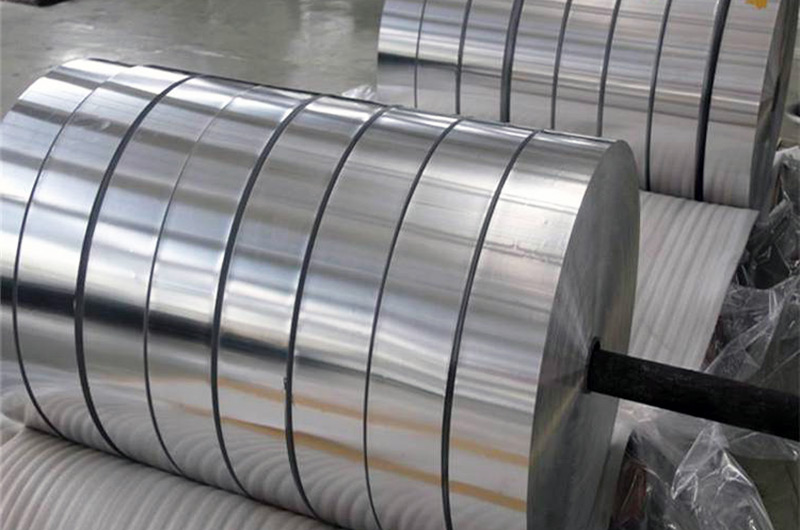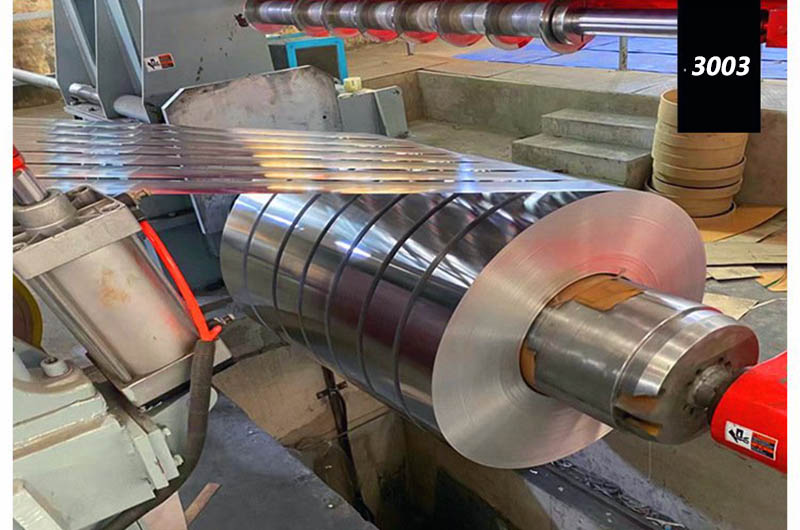- Introduction to 3003 Aluminum Strip
- Advantages of 3003 Aluminum Strip
- Disadvantages of 3003 Aluminum Strip
- 3003 Aluminum Strip Formability and Processability
- Corrosion Resistance
- Commonly Used Width Tabular Format
- 3003 Aluminum Strip Surface Finish
- 3003 Aluminum Strip Chemical Composition
- 3003 Aluminum Strip Mechanical Properties
- 3003 Aluminum Strip Physical Properties
- Common Applications of 3003 Aluminum Strips
- Equivalent 3003 Aluminum Strips for Specific Applications
- 3003 Aluminum Strip Packaging
- 3003 Aluminum Strip Manufacturing Process
- Hot Topics About 3003 Aluminum Strip
Introduction to 3003 Aluminum Strip
3003 aluminum strip belongs to the 3000 series of aluminum alloys, known for its excellent corrosion resistance, formability, and weldability. It is a non-heat-treatable alloy primarily composed of aluminum and manganese. The addition of manganese enhances the alloy's strength and corrosion resistance.
3003 aluminum strip finds widespread use in various applications due to its versatile properties.

Advantages of 3003 Aluminum Strip
1. Corrosion Resistance
3003 aluminum strip has excellent corrosion resistance, making it suitable for applications where exposure to moisture or corrosive environments is a concern.
2. Formability and Processability
This alloy exhibits good formability and is easily processed through methods such as bending, deep drawing, and roll forming, making it adaptable to various manufacturing techniques.
3. Weldability
3003 aluminum strip is highly weldable, allowing for efficient joining processes. It can be welded using various methods, including arc welding and resistance welding.
4. Moderate Strength
While not as strong as some other alloys, 3003 aluminum offers moderate strength, sufficient for many applications where high strength is not the primary requirement.
5. Ease of Machining
The alloy's composition contributes to its machinability, allowing for ease of machining and fabrication.
Disadvantages of 3003 Aluminum Strip
1. Limited Strength
Compared to some other aluminum alloys, 3003 has moderate strength. Applications requiring higher strength may necessitate the use of a different alloy.
2. Heat Treatment Limitations
3003 aluminum is a non-heat-treatable alloy, limiting its ability to achieve enhanced mechanical properties through heat treatment.
3003 Aluminum Strip Formability and Processability
3003 aluminum strip is highly formable and easily processed through various manufacturing techniques, including:
- Bending: The strip can be bent to conform to specific shapes without cracking.
- Deep Drawing: Suitable for applications requiring intricate shapes and deep-drawn components.
- Roll Forming: The strip is well-suited for roll forming processes, enabling the production of profiles for diverse applications.
Corrosion Resistance
3003 aluminum strip is known for its excellent corrosion resistance, particularly in moist or mildly corrosive environments. This property makes it a suitable choice for applications where protection against corrosion is critical.
Commonly Used Width Tabular Format
20-100 mm 3003 Aluminum Strip
Common Applications: Electrical industry, small components.
100-300 mm 3003 Aluminum Strip
Common Applications: Automotive trim, decorative elements.
300-600 mm 3003 Aluminum Strip
Common Applications: Roofing, cladding, architectural components.
600-1200 mm 3003 Aluminum Strip
Common Applications: Heat exchanger fins, evaporator coils.
1200+ mm 3003 Aluminum Strip
Common Applications: Building facades, large structural components.

3003 Aluminum Strip Surface Finish
3003 aluminum strips can be finished in various ways, including:
- 3003 mill finish aluminum strips
- 3003 anodized finish aluminum strips
- 3003 painted finishes aluminum strips
The choice of finish depends on the application's aesthetic and functional requirements.
3003 Aluminum Strip Chemical Composition
- Aluminum (Al): 98.6%
- Manganese (Mn): 1.2-1.8%
- Iron (Fe): 0.7%
- Copper (Cu): 0.05-0.20%
- Zinc (Zn): 0.1%
- Others (each): 0.05%
- Others (total): 0.15%
3003 Aluminum Strip Mechanical Properties
- Tensile Strength (σ): 130 MPa (approx.)
- Yield Strength (σ0.2): 125 MPa (approx.)
- Elongation (A50): 15% (approx.)
3003 Aluminum Strip Physical Properties
- Density: 2.73 g/cm³
- Melting Point: 655°C
- Thermal Conductivity: 190 W/(m·K)
- Electrical Conductivity: 30% IACS

Common Applications of 3003 Aluminum Strips
3003 Aluminum Strip for Electrical Industry
Width: 20-100mm
Temper: O (Annealed)
Specifications: ASTM B209, EN 485
Example: Electrical connectors, small components in electronic devices.
3003 Aluminum Strip for Automotive Trim
Width: 100-300mm
Temper: H14, H16
Specifications: AMS 4008, ASTM B209
Example: Trim strips, decorative elements in automotive interiors.
3003 Aluminum Strip for Roofing and Cladding
Width: 300-600mm
Temper: H24
Specifications: ASTM B209, EN 573
Example: Roofing panels, architectural components.
3003 Aluminum Strip for Heat Exchanger Fins
Width: 600-1200mm
Temper: H16, H18
Specifications: AMS 4008, ASTM B209
Example: Fins for heat exchangers, evaporator coils.
3003 Aluminum Strip for Building Facades
Width: 1200+mm
Temper: H18
Specifications: AMS 4008, ASTM B209
Example: Large structural components, building facades.
Equivalent 3003 Aluminum Strips for Specific Applications
1100 Aluminum Strip
For applications where corrosion resistance and formability are crucial, 1100 aluminum can be considered. It is particularly suitable for electrical and general fabrication applications.
5052 Aluminum Strip
When higher strength is needed, especially in marine environments, 5052 aluminum can serve as an alternative. It offers better strength characteristics while maintaining good formability.
6061 Aluminum Strip
In applications requiring a balance of strength, corrosion resistance, and machinability, 6061 aluminum may be a suitable alternative. It is often used in structural components.
Transportation Precautions:
3003 Aluminum Strip Packaging
Proper packaging to prevent scratching or damage during transportation.
Protection against exposure to moisture to maintain corrosion resistance.
Handling
Careful handling to avoid bending or deformation during transportation.
Temperature Considerations
Avoid extreme temperature variations during transportation, as this may affect the material's properties.
3003 Aluminum Strip Manufacturing Process
1. Casting
Production starts with the casting of the aluminum alloy.
2. Hot Rolling
The cast material is hot-rolled to the desired thickness.
3. Cold Rolling
Cold rolling further refines the strip's thickness and imparts specific mechanical properties.
4. Annealing
Annealing is performed to enhance the material's formability and relieve internal stresses.
5. Finishing
The strip may undergo surface finishing processes, such as anodizing or painting.
Hot Topics About 3003 Aluminum Strip
Sustainability in Building Applications
Discussion on the increasing use of 3003 aluminum in sustainable building practices due to its recyclability and corrosion resistance.
Advancements in Surface Finishing
Exploring recent developments in surface finishing techniques for 3003 aluminum, enhancing both aesthetics and performance.
Innovations in Forming Processes
Overview of innovative forming processes that leverage the formability of 3003 aluminum in the manufacturing of complex components.
Industry-Specific Case Studies
Real-world examples of how 3003 aluminum strip is being used in specific industries, highlighting its advantages and addressing challenges.
Collaborations for Enhanced Properties
Collaborative efforts between manufacturers and research institutions to improve the mechanical properties of 3003 aluminum for specialized applications.
In conclusion, 3003 aluminum strip offers a versatile solution for a wide range of applications due to its corrosion resistance, formability, and weldability.
Understanding its properties, applications, and considerations during transportation and manufacturing is crucial for maximizing its benefits in various industries.
